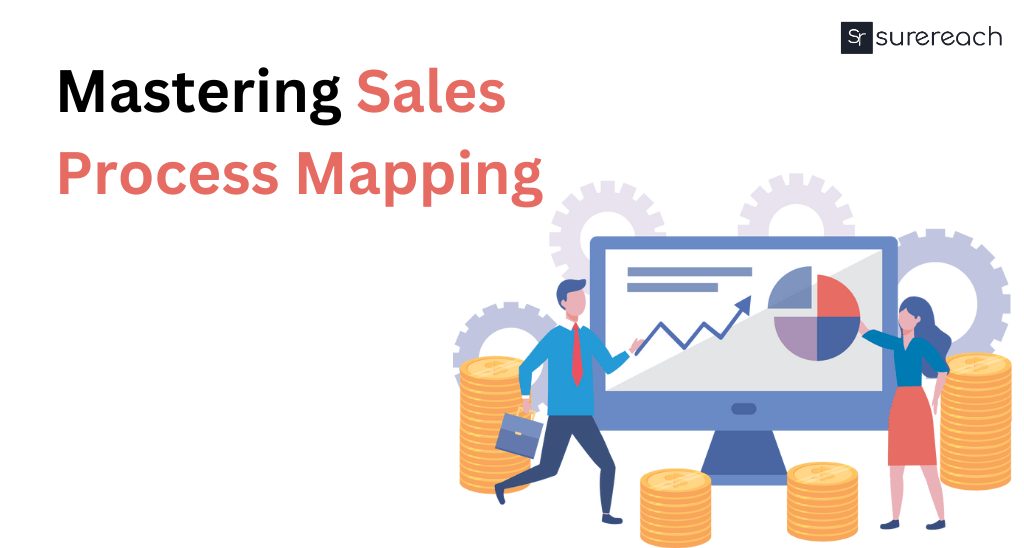What is the Sales Process?
A sales process consists of several standardized, repeatable phases that, when followed, provide a certain, expected result. To put it another way, you should anticipate that the outcomes will be the same or comparable to the last time if you follow all the instructions.
Recognising each phase and knowing how to replicate it are crucial.
A sales technique and a sales process are not the same thing, though. As a result, even if these two names do somewhat overlap, they cannot be used interchangeably. Conversely, a sales technique refers to the manner in which you conduct and execute sales.
However the primary distinction between a sales process and a sales methodology is that the former must be customized for each organization, whilst the latter may be successfully used by several businesses using the same approach.
Sales Process Mapping
Sales process mapping is a useful technique that may help your sales team succeed; it’s not simply a theoretical exercise.
It will be easier for you and your team to move prospects through the sales funnel swiftly and successfully if you have a well-defined and implemented sales process.
You may attain consistency, productivity, and better client connections with a well-defined and flexible sales process, which will help you stay on pace to meet your organization’s sales targets.
Sales Mapping- its Importance
One of the main advantages of sales process mapping is that it gives your sales efforts the much-needed uniformity and predictability. You’re essentially providing your team with a clear route to deal closure by outlining and standardizing the processes that result in successful sales. A clearly defined sales process makes it possible to track performance, identify bottlenecks, and implement data-driven changes.
- Time savings and efficiency: Your sales representatives may wind up chasing the incorrect prospects or squandering valuable time on ineffective activities if your sales process isn’t well-planned. However, they may more effectively manage their time by concentrating on the most promising leads and prospects if they have a clear plan. Shorter sales cycles and a highly motivated sales staff are the results of this.
- Improved Sales Projection. In addition to charting the process, you’re gathering useful information that will enable you to forecast future sales performance more precisely. Put an end to conjecture and adopt logical tactics and reasonable sales objectives.
- Improved Customer Experience. It takes more than merely pressuring leads to sign the contract. Another goal of sales process mapping is to provide your prospective clients with an excellent experience. A well-organized procedure ensures that every client receives the support and information they require at every turn. It’s similar to customisation on steroids, enabling your staff to better understand their requirements and areas of discomfort while fostering deeper bonds in the process.
- Successful Onboarding and Training. It is easy to train new representatives when the sales process is well-documented. They may hone their talents, learn from encounters that work, and adhere to the tried-and-true procedures. In this manner, your team functions as a cohesive one, operating as one well-oiled machine.
Sign up and get 20 credits for free!
We have 3 million+ contacts stored to connect you with prospects all over India
Sales Process Map- How to do it?
- Decide on Your Objective
You should start at the conclusion of your sales process and consider your particular goals while sketching it out.
This may be producing more leads, expanding your clientele, cutting down on attrition, raising your profit margin, or raising sales by a specific percentage.
If you’re wondering why we’re going backwards, the explanation is simple: your sales process map functions similarly to a GPS system, therefore adding your end destination comes before creating your journey.
Having a map of your sales process helps ensure that you never get off track. It gives you a bird’s-eye perspective so that everyone on your team understands how their contributions contribute to the overall objective.
It keeps the members of your sales team inspired to keep going.
Your sales team will have a goal to work towards and a roadmap to assist them get there quickly if they have a clear goal in mind and have mapped out every step that needs to be completed.
-
Include everyone who are involved
While the sales department leads the process, other teams contribute as well to the end result, which in this case is sealing a purchase.
Recall that your IT department, customer service, and marketing teams, to mention a few, are crucial in drawing in new clients, guiding them through the buying process, and assisting them in reaching a sales decision.
Put another way, they should all be mapped out in your sales process as they are all stakeholders who help you achieve your common objective. As they have experience, they may provide some really insightful advice, so find out what they think and encourage them to express it.
-
Specify the Steps in Your Sales Process
Getting everyone to compile a list of the actions they do during the sales process is crucial at this point. Every employee in your marketing, sales, and other departments should examine how they contribute to the process of moving a prospect through the sales funnel. By now, they ought to be aware of which specific actions are successful and efficient. To do this, each of your teams must investigate the prior sales that were closed effectively.
Since it’s quite likely that some of these processes deviate from the norm, it’s critical to investigate and analyze these variations to determine why they happened and why they worked. If there were any obstacles along your path, you should also indicate how they were overcome.
You may also determine exactly what speeds up the process by measuring the intervals between each stage. Compare a standard sale to one that happens more quickly to obtain a deeper understanding of this issue and identify the shared elements that expedited transactions have in common. This will enable you to determine why they were successful.
-
Link These Actions To The Phases Of The Buyer Journey
You must match these procedures to the phases of the buyer experience for them to make sense.
The phases of awareness, contemplation, and decision-making are on the one hand, while the actions of prospecting, connecting, researching, presenting, and closing are on the other.
This may be achieved by developing buyer personas and learning everything there is to know about your target audience’s characteristics. Ensure you examine what they require and accomplish at each phase of their purchasing process.
Finding the triggers that advance them from one level to the next, however, is crucial. You may identify these times of compelling action and specific information that prompted people to take action by looking at your past data, which will assist you in this endeavour.
Additionally, it’s critical to smoothly integrate the financial and invoicing components while taking the customer journey stages into account. You’ll get aid with this from tools like Hiveage.
-
Monitor Your Outcomes
It’s crucial to assess if the stages are effective and identify areas for improvement once you’ve sketched them out.
Choose your measurement objectives, since this will help you choose the KPIs and metrics that matter most. Put differently, it’s critical to define success according to your own standards.
Consider the objective that was stated at the beginning of this section and define “successful” in terms of producing new leads or a “successful” conversion rate.
Conclusion
Creating a map of your sales process enables you to stand back and view the wider picture. It assists you in determining which of your present routines are effective and ineffective. You may use it to see where improvements can be made by visualizing each stage of the sales process. Your sales staff will be able to complete more transactions faster if you have well-defined procedures since there will be less uncertainty and they will always know what to do.








Sanidhya Arora
More posts by Sanidhya Arora